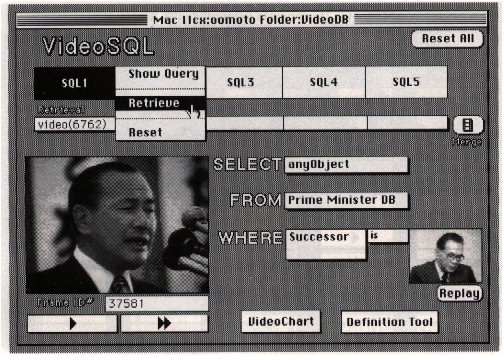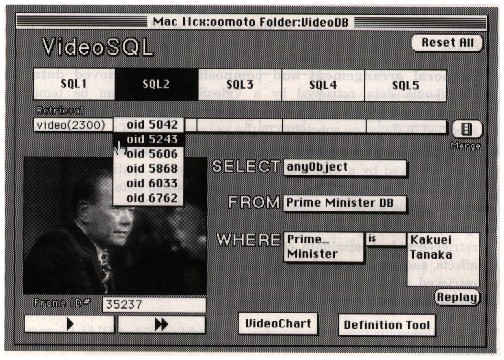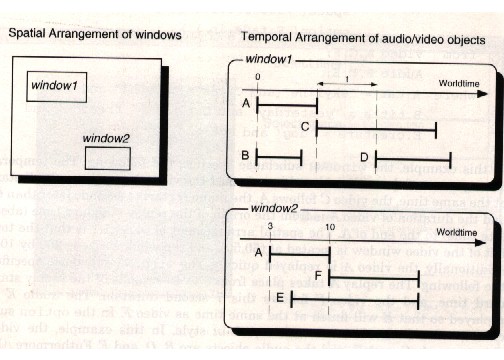
 Chapter 13
Chapter 13
Components of OVID System
VideoSQL
VideoSQL
is a query language of OVID for retrieving video-objects.
Here is an example.

Figure 11. VideoSQL.
-
Users can formulate VideoSQL queries in a fill-in-the-blank manner
-
The result of a VideoSQL query is a collection of video-objects that satisfy the specified condition.
-
A VideoSQL query consists of the following clauses
-
SELECT clause: It is quite different from ordinary SQL. It specifies only the category of the resulting video-objects.
-
Continuous: only the video-objects consisting of a single sontinuous video frame sequences are retrieved.
-
Incontinuous: only these consisting of more than one continuous video frame sequence are retrieved.
-
anyObject: the system retrieves all types of video objects, whether they are continuous or not.
-
FROM clause: specify the name of the video database.
-
WHERE clause: specify the condition, consisting of attribute/value pairs and comparison operators. Attribute names can be selected by means of a pop-up menu.
Currently following conditions are supported:
-
[attribute] is [value | video object ]
This condition results in the return of video-object which have the specified attribute value or video-object.
example
-
[attribute] contains [value | video object]
It stipulates to return video-objects which contain the specified value or the specified video-object in the set value of the specified attribute.
-
definedOver [ video sequence | video frame ]
This condition orfers the return of video-objects that are defined over the specified video frame sequence or frame.
For example: definedOver frame(15000)
causes the retrieval of the video-objects which include the video frame with frame#:15000 in their defined video sequence.

Figure 12. The selection of one of the retrievals.
-
Other features of VideoSQL
-
VideoSQL can formulate more than one query and savetheir retrival results at the same time.
-
Retrived video-objects are able not only to be replayed, but to become operands of the Merge operation as well.
-
How to display the query, see figure.
click the Merge button to merge several video-objects from different retrieving results.
-
Extensions of VideoSQL
-
Temporal arrangement and composition of retrieved data The temporal arrangementof video/audio data is specified in the time subclause in the select clause of a VideoSQL query.
-
Spatial arrangement and composition of retrieved data : specified in the space subclause.
-
Special effect for retrieved data Temporally- and spatially- arranged retrieved video/audio data can be displayed with several special visual effects, such as mosaic, fade-in/out, etc. These are specified in the option subclause.
-
Example:
select window1 { time{ start(A, B);
follow(A, C);
startstart(C, D(t));
Worldtime(A: 0, *) }
space{ +50+50@200*100 }
option{ A:fast } }
window2{ time{ Worldtime( A:3, 10);
follow(A, F);
end(E, F) }
space{ +300+300@150*60 }
option{ F: fade-in } }
from Video A, C, F;
Audio B, D, E;
where A.car = 'skyline' and C.car = 'corona' and
B.title = 'yesterday' and D.title = 'freedom' and
E.creature = 'dog' and F.title = 'thriller'
-
Decomposing(disaggregating) video-objects.
-
Moving to the cideo object definition tool and VideoSQL.

Figure 13. An example retrieval for both audio and video objects.





